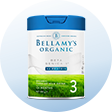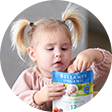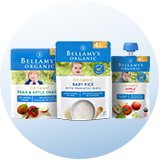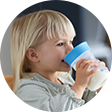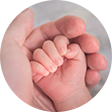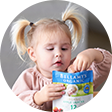Signs of Coeliac Disease in Infants and Children
In babies, signs of coeliac disease may be signalled from gastrointestinal clues such as:
- frequent pale mucousy stools which escape the confines of the nappy
- constant crying and pulling up of the legs as if to ease stomach pain
- poor appetite may result from stomach pain and discomfort
- nausea and vomiting
- swollen tummy
In coeliac disease gluten damages the lining of the small intestine which absorbs the nutrients from our food. Coeliac disease requires life-long avoidance of gluten proteins found in the grains, wheat, spelt, rye, triticale, barley and controversially oats. Once thought of as a childhood disorder that was outgrown, we now know that coeliac disease can be diagnosed at any age. Symptoms of coeliac disease vary a great deal. About twenty percent don’t feel they have any symptoms at diagnosis and about half don’t have gastrointestinal symptoms.
A poor appetite means your baby or child will eat less food. A damaged small intestine means the child will not absorb some of the food it does eat. Therefore other signs to look out for include:
- poor weight gain
- weight loss or failure to thrive
- tiredness with lack of energy
- pale skin
- dark circles under the eyes
- easy bruising
- wasted muscles
- changes in behaviour, mood and loss of usual enthusiasm in daily activities
Contrary to this, some children become ravenously hungry when their food nutrients are not being absorbed. If they are eating and drinking lots of food and not gaining weight, this too is a sign to look out for. While some don’t sleep because of discomfort, others sleep more once the fatigue and tiredness sets in.
Diagnosing Coeliac Disease
Coeliac disease shows up after the child starts to eat gluten. In children who carry the genes associated with coeliac disease, gastroenteritis infections early in life, may be one environmental trigger that makes your child more susceptible to developing coeliac disease. If concerned, breast feeding mothers can continue to eat wheat themselves. If the child has coeliac disease, the enzymes to break down lactose (milk sugar) are reduced or lost when the small bowel is damaged by gluten. Going lactose free may help ease symptoms, but this is only masking the real problem.
Gluten must remain in your child’s diet in order to diagnose coeliac disease
After you have introduced gluten foods to your child, if you notice any of the changes above and they are unexplained and not resolving, investigate them with your baby’s doctor as soon as possible. Getting a proper medical diagnosis is important. The usual coeliac-specific antibody screen is not so useful in babies under two years and is more accurate in children over five years of age. A small bowel biopsy might be advised. Be guided by your doctor and Paediatric Gastroenterologist. It’s important to see a dietitian who specialises in coeliac disease to help you manage a gluten free diet for your child.
References
1. Brown AC. Gluten sensitivity: problems of an emerging condition separate from celiac disease. Expert Review of Gastroenterology & Hepatology, 2012;6(1), 43-55, DOI: 10.1586/egh.11.79
2. Myléus et al. Early infections are associated with increased risk for celiac disease: an incident case-referent study. BMC Pediatrics 2012, 12:194 http://www.biomedcentral.com/1471-2431/12/194










